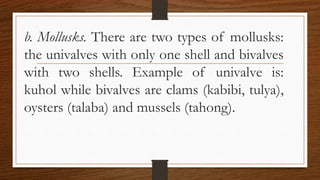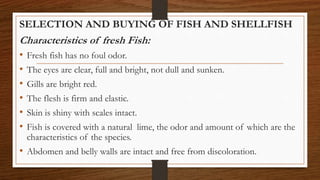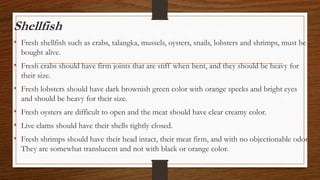Selecting and storing seafood
- 3. Unlocking of difficulties: ? Seafood - any sea animal or seaweed that is served as food. ? Specks - small spots ? Visceral - internal organs ? Eviscerated - to remove the essential parts ? Thorax - the part of the body between the neck and the abdomen
- 4. Types of Sea food Vertebrate or Finfish Shellfish Crustaceans Cephalopods Mollusks Univalves Bivalves
- 5. Types of Seafood 1. Vertebrate or finfish. ?These are fishes that has a back bone and its flesh is edible. ?These are bangus, bisugo, tilapia, dalag, catfish and other fresh water fish.
- 6. 2. Shellfish. Shellfish can be classified into: crustaceans, mollusks and cephalopods.
- 7. a.Crustaceans are shellfishes with hard shells over the back of the body and along the claws but have softer shells covering the lower part of the body and legs. Ex. Crabs, lobster and shrimps.
- 8. b. Mollusks. There are two types of mollusks: the univalves with only one shell and bivalves with two shells. Example of univalve is: kuhol while bivalves are clams (kabibi, tulya), oysters (talaba) and mussels (tahong).
- 9. ?Cephalopods have reduced internal shell. Squid, cuttlefish and octopus belong to this classification.
- 10. SELECTION AND BUYING OF FISH AND SHELLFISH Characteristics of fresh Fish: ? Fresh fish has no foul odor. ? The eyes are clear, full and bright, not dull and sunken. ? Gills are bright red. ? The flesh is firm and elastic. ? Skin is shiny with scales intact. ? Fish is covered with a natural lime, the odor and amount of which are the characteristics of the species. ? Abdomen and belly walls are intact and free from discoloration.
- 11. Shellfish ? Fresh shellfish such as crabs, talangka, mussels, oysters, snails, lobsters and shrimps, must be bought alive. ? Fresh crabs should have firm joints that are stiff when bent, and they should be heavy for their size. ? Fresh lobsters should have dark brownish green color with orange specks and bright eyes and should be heavy for their size. ? Fresh oysters are difficult to open and the meat should have clear creamy color. ? Live clams should have their shells tightly closed. ? Fresh shrimps should have their head intact, their meat firm, and with no objectionable odor. They are somewhat translucent and not with black or orange color.
- 12. Market Forms of Fish Live Fish There are fishes which can be marketed alive because they live long after catch. Good examples of these are dalag, hito and tilapia.
- 13. Whole or round fish Most fresh fish is distributed in local market fish stalls as whole or round fish. Shortly after catch, fish is chilled in ice to prevent spoilage.
- 14. Drawn fish This is a whole fish with the entrails removed. Preparation for cooking involves scaling and cutting as needed. Most fish in modern supermarkets are available in this form.
- 15. Dressed fish Dressed fish has been scaled and eviscerated. Often the head, tail and fins are also removed.
- 16. Deboned This is the form most convenient in the case of bangus. The deboned bangus is sold frozen often times marinated and ready-to- cook.
- 17. Steaks These are cross section slices of dressed large fishes. A portion of the backbone is usually the only in a fish steak. Steaks which are half to two thirds of an inch thick are usually best. Steaks cut away from visceral cavity are solid slices and are preferred by discrimination of consumers.
- 18. Sticks These are fillets or steaks cut further into smaller uniform pieces like sticks. They are usually breaded and frozen.
- 19. Flaked Fish meat separated from the whole fish is called flaked fish. Labahita is commonly made into flaked fish.
- 20. Market Forms of Shellfish Live Crabs, clams, mussels, oysters, snails and lobsters should be alive if purchased in the shell except for boiled crabs and lobsters. Ideally, shrimps should also be marketed alive.
- 21. Whole Most shrimps marketed locally are whole.
- 22. Shucked These are bivalves or mollusks which have been removed from the shell. Oysters, clams and scallops may be sold in this form; Fresh shucked oysters have a translucent appearance. They become opaque with standing.
- 23. Headless ?Most shrimps, prawns and lobsters for exports are marketed in the headless form, the head and thorax are removed. ?The head is removed mainly because it is the main source of bacterial spoilage during transport and also because it does not appeal to most foreign palates.
- 24. Cooked Shellfish Shrimps, crabs and lobsters may be cooked in the shell prior to marketing.
- 25. Cooked Meat The meat of shrimps, crabs and lobsters may be marketed cooked, usually in cans.
- 26. Handling, Storing and Thawing Fish ? Fish and fishery products are transported in fishing boats or commercial ships. ? Higher value fishery products like shrimps and prawns and special fish varieties especially those intended for restaurants and other institutional food service establishments may be transported by air.
- 27. ?Land transportation for large quantities can be in open truck but the most common means of transporting up to 1000 kg is by owner type jeepneys. ? Insulated fish boxes or tubs are arranged on platforms as the rear end of vehicle.
- 28. ? The method of handling and transport of fish as practiced may not always be for keeping the fish at optimum quality. ? But while both fisherman and trader are aware of this, cost considerations always prevail. ? Bigger fish operators, however, make sure that proper holding temperature of not more than 4?C can be achieved with adequate icing and true insulated fish boxes.
- 29. ? A water-soluble synthetic co-polymer with cold-retention ability is used to keep fish frozen during transport. ? The material is initially a powder that becomes a gel when water is added. ? The resulting gel is frozen at 40 to 30?C before using. The fish is placed between bags of this frozen gel.
- 30. ? The fish to be packed has to be cooled down first because the gel cannot cool fish at ambient temperature but it can maintain a cold temperature that will avoid thawing of an already frozen fish. ? The advantage of the gel pack is that it does not drip like ice so it is particularly suitable for air transport.
- 31. ? The fish to be packed has to be cooled down first because the gel cannot cool fish at ambient temperature but it can maintain a cold temperature that will avoid thawing of an already frozen fish. ? The advantage of the gel pack is that it does not drip like ice so it is particularly suitable for air transport.
- 32. Product Refrigerator (35-40?F) Freezer ( 0o ) Fresh water fish, cleaned Fillets Steaks Cooked fish Smoked fish Canned fish Clams, oyster (shucked) Crabs Shrimps 3 ¨C 5 days 2 ¨C 3 days 3 ¨C 5 days 3 ¨C 4 days 1 ¨C 2 weeks 1 day 7 ¨C 9 days 7 days 3 ¨C 5 days 6 ¨C 9 months 4 ¨C 6 months 2 months 1 month 4 ¨C 5 weeks NR 3 ¨C 4 months 2 months 6 ¨C 12 months Storage Times for Seafood
































